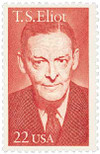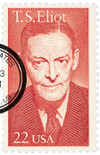
# 2239 - 1986 22c Literary Arts: T. S. Eliot
U.S. #2239
1986 22¢ T. S. Eliot
Literary Arts Series
- Issued on Eliot’s 98th birthday
- Fifth stamp in Literary Arts Series
Stamp Category: Commemorative
Series: Literary Arts
Value: 22¢, first-class rate
First Day of Issue: September 26, 1986
First Day City: St. Louis Missouri
Quantity Issued: 131,700,000
Printed by: Bureau of Engraving and Printing
Printing Method: Engraved
Format: Panes of 50 in sheets of 200
Perforations: 11
Color: Copper red
Why the stamp was issued: To commemorate Eliot’s 98th birthday.
About the stamp design: Bradbury Thompson, who’d designed all the previous Literary Arts stamps, based his image of Eliot on a photo from the New York Times.
First Day City: The First Day ceremony for this stamp was held in the Missouri Historical Society in St. Louis, Missouri, the town of Eliot’s birth.
About the Literary Arts Series: The Literary Arts Series began in 1979 with a John Steinbeck stamp. (Click here to get every stamp in the series issued from 1979 to 2021.) The objective of the Literary Arts Series is to honor America’s most renowned authors. As the USPS put it, “These skillful wordsmiths spun our favorite tales – and American history along with them.” The series honors both well-known and lesser-known authors, making it like an encapsulation of America’s rich and varied literary history.
History the stamp represents: Thomas Stearns Eliot was born on September 26, 1888, in St. Louis, Missouri. Eliot attended schools in St. Louis and Massachusetts before entering Harvard in 1906. After graduating, he worked at the school for a year as a philosophy assistant before heading to France and England to further study philosophy.
Eliot returned to Harvard to study Indian philosophy and Sanskrit but was drawn back to England for study. He worked toward earning a Ph.D., but never took his final oral exam. Instead, he married and worked in London as a teacher and then a bank clerk.
During this time, Eliot befriended poet Ezra Pound, who instantly recognized his poetic talent and encouraged him and helped to get his work published. Eliot published his first poem of this period in 1915 – “The Love Song of J. Alfred Prufrock.” Two years later he published his first book of poems, Prufrock and Other Observations. The success of this book helped establish Eliot as one of the world’s leading poets of the time. In addition to writing poems and working a regular job, Eliot also wrote literary criticism and reviews that were also well respected.
In 1922, Eliot published “The Waste Land,” a long and complex story of postwar disillusionment. “The Waste Land” was instantly recognized throughout the literary world and came to be seen as one of the most influential poems of the 20th century. Eliot was seen as a revolutionist, introducing new subject matter and techniques to poetry.
That same year Eliot founded the Criterion literary journal and worked as its editor for 17 years. In 1925, he left his bank job to work for the publishing house, Faber and Faber. He would spend the rest of his life there, encouraging young poets. Eliot also continued to write his own work. He only published two or three poems a year, demanding that they, “should be perfect in their kind, so that each should be an event.”
Eliot became a British citizen in 1927 and converted to Anglicanism, which is reflected in his poem “Ash Wednesday.” During his career, Eliot also wrote seven plays, including Murder in the Cathedral and The Cocktail Party. The beloved play Cats was based on Eliot’s series of 14 poems, Old Possum’s Book of Practical Cats. He also won the Nobel Prize in Literature in 1948.
Eliot died of emphysema on January 4, 1965, in London. He is often seen as one of the 20th century’s major poets.
U.S. #2239
1986 22¢ T. S. Eliot
Literary Arts Series
- Issued on Eliot’s 98th birthday
- Fifth stamp in Literary Arts Series
Stamp Category: Commemorative
Series: Literary Arts
Value: 22¢, first-class rate
First Day of Issue: September 26, 1986
First Day City: St. Louis Missouri
Quantity Issued: 131,700,000
Printed by: Bureau of Engraving and Printing
Printing Method: Engraved
Format: Panes of 50 in sheets of 200
Perforations: 11
Color: Copper red
Why the stamp was issued: To commemorate Eliot’s 98th birthday.
About the stamp design: Bradbury Thompson, who’d designed all the previous Literary Arts stamps, based his image of Eliot on a photo from the New York Times.
First Day City: The First Day ceremony for this stamp was held in the Missouri Historical Society in St. Louis, Missouri, the town of Eliot’s birth.
About the Literary Arts Series: The Literary Arts Series began in 1979 with a John Steinbeck stamp. (Click here to get every stamp in the series issued from 1979 to 2021.) The objective of the Literary Arts Series is to honor America’s most renowned authors. As the USPS put it, “These skillful wordsmiths spun our favorite tales – and American history along with them.” The series honors both well-known and lesser-known authors, making it like an encapsulation of America’s rich and varied literary history.
History the stamp represents: Thomas Stearns Eliot was born on September 26, 1888, in St. Louis, Missouri. Eliot attended schools in St. Louis and Massachusetts before entering Harvard in 1906. After graduating, he worked at the school for a year as a philosophy assistant before heading to France and England to further study philosophy.
Eliot returned to Harvard to study Indian philosophy and Sanskrit but was drawn back to England for study. He worked toward earning a Ph.D., but never took his final oral exam. Instead, he married and worked in London as a teacher and then a bank clerk.
During this time, Eliot befriended poet Ezra Pound, who instantly recognized his poetic talent and encouraged him and helped to get his work published. Eliot published his first poem of this period in 1915 – “The Love Song of J. Alfred Prufrock.” Two years later he published his first book of poems, Prufrock and Other Observations. The success of this book helped establish Eliot as one of the world’s leading poets of the time. In addition to writing poems and working a regular job, Eliot also wrote literary criticism and reviews that were also well respected.
In 1922, Eliot published “The Waste Land,” a long and complex story of postwar disillusionment. “The Waste Land” was instantly recognized throughout the literary world and came to be seen as one of the most influential poems of the 20th century. Eliot was seen as a revolutionist, introducing new subject matter and techniques to poetry.
That same year Eliot founded the Criterion literary journal and worked as its editor for 17 years. In 1925, he left his bank job to work for the publishing house, Faber and Faber. He would spend the rest of his life there, encouraging young poets. Eliot also continued to write his own work. He only published two or three poems a year, demanding that they, “should be perfect in their kind, so that each should be an event.”
Eliot became a British citizen in 1927 and converted to Anglicanism, which is reflected in his poem “Ash Wednesday.” During his career, Eliot also wrote seven plays, including Murder in the Cathedral and The Cocktail Party. The beloved play Cats was based on Eliot’s series of 14 poems, Old Possum’s Book of Practical Cats. He also won the Nobel Prize in Literature in 1948.
Eliot died of emphysema on January 4, 1965, in London. He is often seen as one of the 20th century’s major poets.












